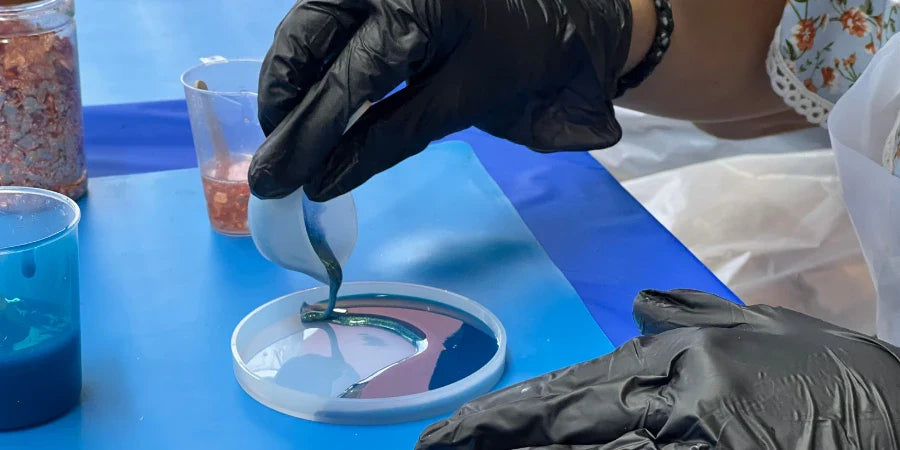How Different Environments Affect Resin Performance?
Resin, a versatile material prized for its clarity, durability, and aesthetic appeal, finds application in various environments. From sparkling countertops gracing kitchens to UV-resistant coatings protecting outdoor furniture, understanding how environmental conditions impact resin's performance is crucial for its successful use. This comprehensive guide explores how temperature, UV exposure, chemicals, and mechanical stress influence resin behaviour, empowering you to make informed decisions for your next resin project. We recommend joining a resin art workshop to learn how to start this topic under professional guidance.
The Effect of Temperature on Resin
Temperature plays a significant role in every stage of a resin's life cycle, from its uncured state to its long-term performance. Here's a breakdown of how temperature variations can affect resin:
- Viscosity: As temperatures rise, most resins become less dense, flowing more easily. This can benefit applications requiring good penetration into moulds or intricate details. Conversely, colder temperatures increase viscosity, making the resin thicker and potentially more challenging.
- Curing Speed: Generally, higher temperatures accelerate the curing process of resin. This can be advantageous for projects requiring a faster turnaround time. However, excessively high temperatures can lead to an uncontrolled exothermic reaction, generating excessive heat that can cause warping or cracking in the cured resin.
- Brittleness: Certain types of resin, particularly some epoxies, can become more brittle at lower temperatures. This can make them more susceptible to cracking or shattering under impact. Conversely, high temperatures can soften some resins, reducing their mechanical strength.
Optimising Resin Performance for Temperature Extremes
- Choosing the Right Resin: Different resin formulations are designed to perform well within specific temperature ranges. Please consult the technical datasheet of the resin to ensure it's suitable for the intended environment. Some resins are specifically formulated for high-heat applications, such as countertops or engine components, while others excel in cold environments.
- Temperature Control During Curing: Maintaining a consistent and controlled temperature during the curing process is vital. Ideally, cure the resin within the recommended temperature range specified by the manufacturer. Utilise room temperature curing whenever possible. Use an oven with precise temperature control to prevent overheating for situations requiring heat curing.
Understanding UV Exposure and Resin
Ultraviolet (UV) radiation is a component of sunlight that can significantly impact certain types of resin. Here's how UV exposure can affect resin performance:
- Degradation: Over time, prolonged exposure to UV light can cause some resins to degrade. This can manifest as yellowing, cracking, or a loss of mechanical strength. The degradation rate depends on the specific resin type and the intensity of UV exposure.
- UV Curing Resins: In contrast to the degradation effect, some specialised resins are designed to cure upon exposure to UV light. These resins are often used in 3D printing applications and industrial coatings.
Protecting Resin from UV Damage
- UV-Resistant Resins: When UV resistance is a prime concern, opt for resins formulated with UV stabilisers or inhibitors. These additives help to shield the resin from the damaging effects of UV radiation and extend its lifespan.
- Clear Coats and UV Protection: Applying a UV-protective clear coat to the cured resin surface can offer an additional layer of defence against UV degradation. This is particularly useful for outdoor applications or projects exposed to direct sunlight.
Chemical Resistance of Resin
Resins exhibit varying degrees of resistance to different chemicals. Understanding this aspect is crucial for projects involving potential chemical exposure.
- Common Chemicals: Many resins resist household chemicals like water, mild detergents, and diluted acids or bases. However, some solvents or harsh chemicals can damage the resin, causing it to soften, swell, or crack.
- Chemical Compatibility Check: Always refer to the resin's technical datasheet to verify its compatibility with the chemicals it might encounter in its intended environment.
Safeguarding Resin from Chemical Exposure
- Identify Potential Chemical Exposure: Carefully evaluate the environment where the cured resin will be used. If potential exposure to specific chemicals exists, choose a resin known for its resistance to those chemicals.
- Protective Coatings: For situations where complete isolation from chemicals is impossible, consider applying a protective coating on the cured resin surface. This coating can act as a barrier against chemical attack.
Mechanical Stress and Resin
Another crucial factor to consider is the resin's ability to withstand mechanical stress, such as impacts, scratches, or pressure.
- Resin Type and Strength: Different resin types offer varying degrees of mechanical strength. Epoxies are generally known for their superior strength and rigidity, while some polyesters might be more flexible.
- Impact Resistance: For applications requiring high impact resistance, such as countertops or flooring, choose a resin specifically formulated for such demands.
- Reinforcement Techniques: Incorporating reinforcements like fibreglass or carbon fibre into the resin can significantly enhance its mechanical strength and impact resistance. This technique is often used for high-stress applications like boatbuilding or sporting goods.
Optimising Resin Performance for Mechanical Stress
- Matching Resin to Application: Select a resin with a demonstrated ability to withstand the anticipated mechanical stresses it will encounter in its final use.
- Thickness Considerations: A thicker resin layer generally provides better mechanical stress resistance than a thin layer. However, consider the potential for increased shrinkage with thicker castings.
- Reinforcement Strategies: For projects requiring exceptional strength, explore reinforcement techniques like embedding fibreglass or carbon fibre mesh within the resin during casting.
Beyond the Basics: Environmental Considerations
While this guide has focused on the impact of the environment on resin, it's also important to consider the environmental impact of using resin. Here are some closing thoughts:
- Choosing Eco-Friendly Resins: Several resin manufacturers are developing bio-based or low-VOC (volatile organic compound) resins that offer a more sustainable alternative. Consider exploring these options whenever possible.
- Safe Resin Handling and Disposal: Always adhere to proper safety practices when handling and disposing of resin and its associated solvents. Many localities have specific regulations regarding resin waste disposal. Research and comply with these regulations to minimise environmental impact.












